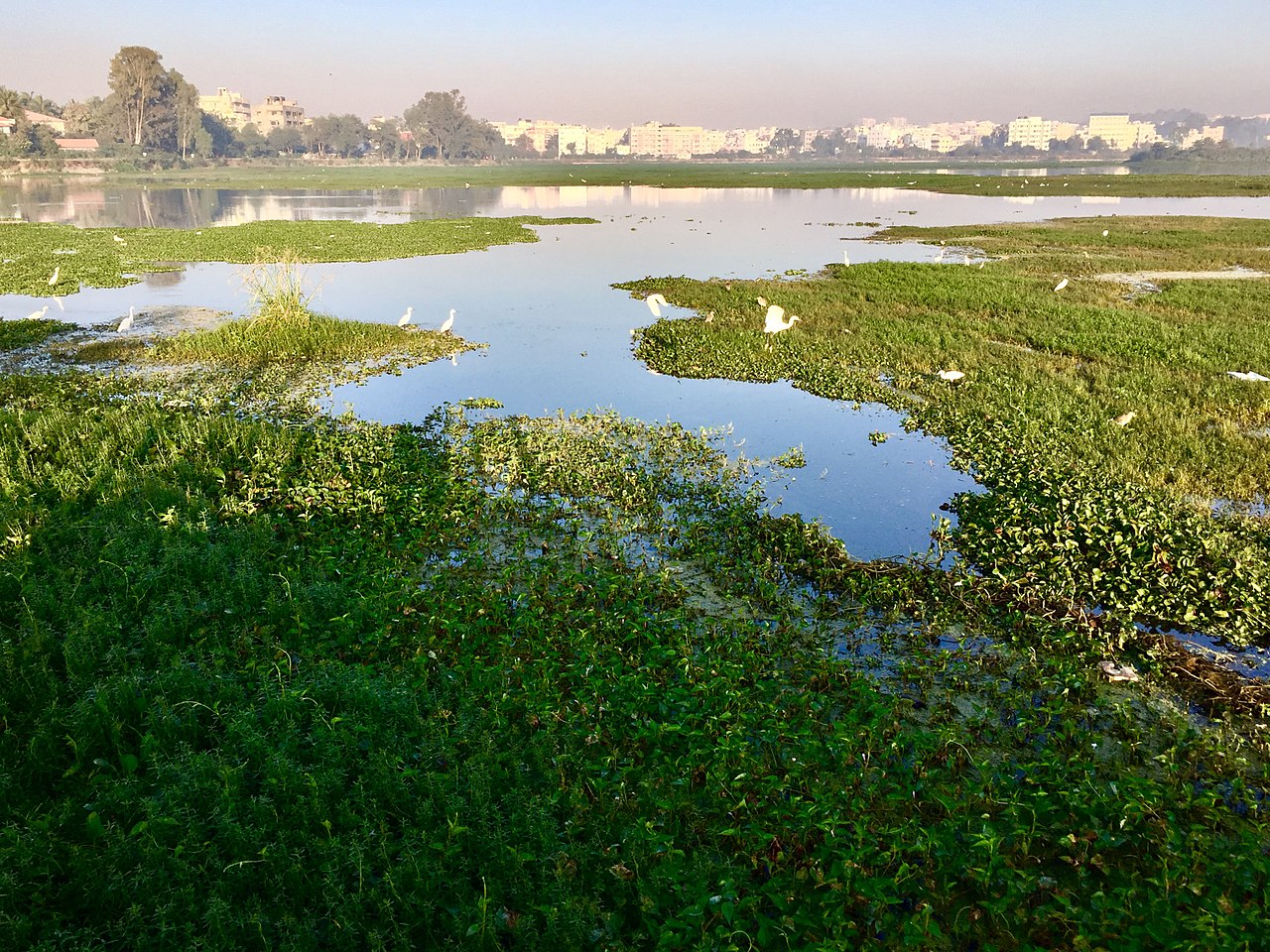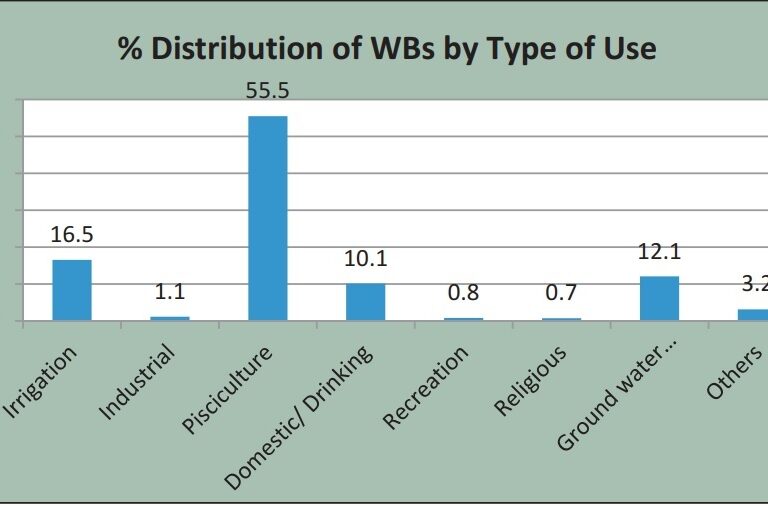- India’s first water body census compiles a state-wise database of location, ownership, size, and usage of ponds, tanks, water conservation structures, reservoirs and lakes.
- Experts flag certain concerns, such as no recognition for ecosystem services and inconsistencies in data.
- Many say, though, that it is a good start and want this report to translate into a better action plan for the protection and management of water bodies.
India’s first water body census, which primarily focused on small water bodies like ponds, tanks, lakes, water conservation structures, and reservoirs, highlighted drawbacks related to their maintenance.
Approximately 1.1 million (45.2%) of the 2.4 million water bodies surveyed across all states and union territories have never been repaired, revealed the census report released last month by the union Ministry of Jal Shakti, India’s water ministry. Another 15.7% of the water bodies were repaired before 2009. The report underlines that the proper repair and upkeep of water bodies are required for their optimum utilisation.
“This is certainly a major anomaly, which shows that India’s water resources are not being optimally utilised,” Ashis Panda, a water expert from Sambhaav Trust, a Rajasthan-based water conservation NGO, told Mongabay-India. Panda said that if water bodies are not repaired in a timely manner, they lose their carrying capacity, mainly due to siltation, waste dumping, or other problems. “There has to be a system in place to periodically review the condition of water bodies so that they perform their function properly and remain useful,” he adds.
There is significant performance variation among the states and union territories on several indicators. For instance, Uttar Pradesh, which accounts for nearly 10% of the total water bodies counted in the census, has the maximum number of non-maintained water bodies, non-functional and encroached water bodies. West Bengal, which has the highest number of water bodies in the country at 30%, did not have a single non-maintained water body.
Of the total 2.4 million water bodies surveyed, 59.5% (1.4 million) were ponds, 15.7% (0.38 million) tanks, and 12.1% (0.29 million) reservoirs. Most of the total enumerated water bodies, 97%, are in rural areas, while the remaining 3% are in urban areas. In the census, water bodies were considered as all natural or man-made units bounded on all sides with some or no masonry work used for storing water for irrigation or other purposes (e.g. industrial, pisciculture, domestic/drinking, recreation, religious, ground water recharge etc.).
The census launched in 2018-19 also pointed out that of 2.4 million water bodies surveyed, 400,000 (16.3%) are not in use because they have either dried up or there is construction, siltation, industrial effluent, destruction beyond repair, salinity or other reasons. Half of these non-functional water bodies are ponds, while the rest are tanks and lakes.
Veena Srinivasan, a water expert from Bengaluru and a senior fellow at Ashoka Trust for Research in Ecology and the Environment (ATREE), told Mongabay-India that the census questionnaire, it seems, left out most common reasons like eutrophication (excess growth of algae), sewage pollution and solid waste dumping while investigating the reasons for so many disused water bodies.
Encroachment, meanwhile, is not a major concern, as is commonly perceived, shows the census report. A minor 1.6% of enumerated water bodies — 38,496 out of 2.4 million — had been encroached upon. There is no encroachment in West Bengal, Sikkim, Arunachal Pradesh and Chandigarh.

Meanwhile, 83.7% of the 2.4 million enumerated water bodies are in use and play an important role in the day-to-day life of people.
However, while determining whether water bodies were functioning or not, the census did not recognise the ecosystem services provided by these water bodies, pointed out environmental activist and water expert Himanshu Thakkar.
Thakkar, who is the coordinator of South Asia Network on Dams, Rivers & People (SANDRP), told Mongabay-India that the water bodies, whether big or small, are important for biodiversity, water harvesting and groundwater recharge. But the census did not analyse the possible impact of water bodies on the ecosystem’s overall health. Thakkar added that doing this would have helped policymakers regulate water bodies in terms of their eco-functioning.
Thakkar also hit out at census for confining the survey to five or six categories of water bodies while excluding rivers, streams, springs, waterfalls, canals, etc.
A challenge to monitor small water bodies
Most of the water bodies in the survey were less than 0.5 hectares (about the size of five Olympic-sized swimming pools).
This makes monitoring of water bodies challenging, notes water expert Srinivasan. Additionally, small water bodies are not eligible for funding under the Central Scheme of Repair, Renovation, and Restoration (RRR) of water bodies as the minimum water spread area in most states is required to be two hectares to get funding under RRR. In northeastern states and Jammu and Kashmir, the size criterion for RRR funds is one hectare.
Given that about 85.8% of the water spread area of water bodies is one hectare and below, most of the surveyed water bodies are not eligible for the funds under the scheme which provides central government’s assistance for comprehensive improvement and restoration of water bodies to increase tank storage capacity, groundwater recharge, increased availability of drinking water, improvement in agriculture/horticulture productivity, etc.

Ownership pattern is another reason that make it challenging to monitor water bodies, experts add. A little over a half, 55%, of the surveyed water bodies are found to be under private ownership, whereas 45% are under public ownership. Of the public-owned water bodies, panchayats own 62% and State Water Resource Department (WRD) or State Irrigation departments own 23%. Out of all privately-owned water bodies, 79% are with individual owners, and 16% are with groups of farmers.

Thakkar pointed out inconsistencies in data collection of the study. For example, he notes, in Karnataka state, the census report has found about 27,000 water bodies, out of which about 21,000 are not in use. But this is in contrast to the findings of a joint survey conducted by the Tank Conservation and Development Authority and Karnataka Public Land Corporation in 2021, which recorded 40,483 water bodies in the state. “How can so many water bodies be wiped out in a matter of a year or so,” he asked, saying that an independent assessment is needed to properly review the data published in the census report.
Water expert from ATREE, Srinivasan, is also of the view that there are inconsistencies in data collection and interpretation, but it is crucial that the government continues such nationwide censuses of a vital resource with modifications. This first edition provides some important findings, which must be translated into an actionable plan, especially in rejuvenating water bodies. Here, rather than a top-down approach which is more of a nexus between consultants and contractors, we need a bottom-up approach where local communities may be involved in reviving and maintaining the water bodies. Funds may be transferred through panchayats or district authorities,” she said. Srinivasan also said that it is certainly a difficult task to engage local communities. But this approach can ensure the integration of communities’ traditional knowledge with the restoration and rejuvenation work of water bodies.
Ashis Panda of Sambhaav said that the data published in the census could have a greater use if it is geo-tagged and present in visual and spatial data format. It will lead to better data verification by different agencies and researchers, leading to better action.
Banner image: A shikara paddles in front of Hari Parbat Fort on Nagin Lake. Photo by Mckay Savage/Wikimedia Commons
